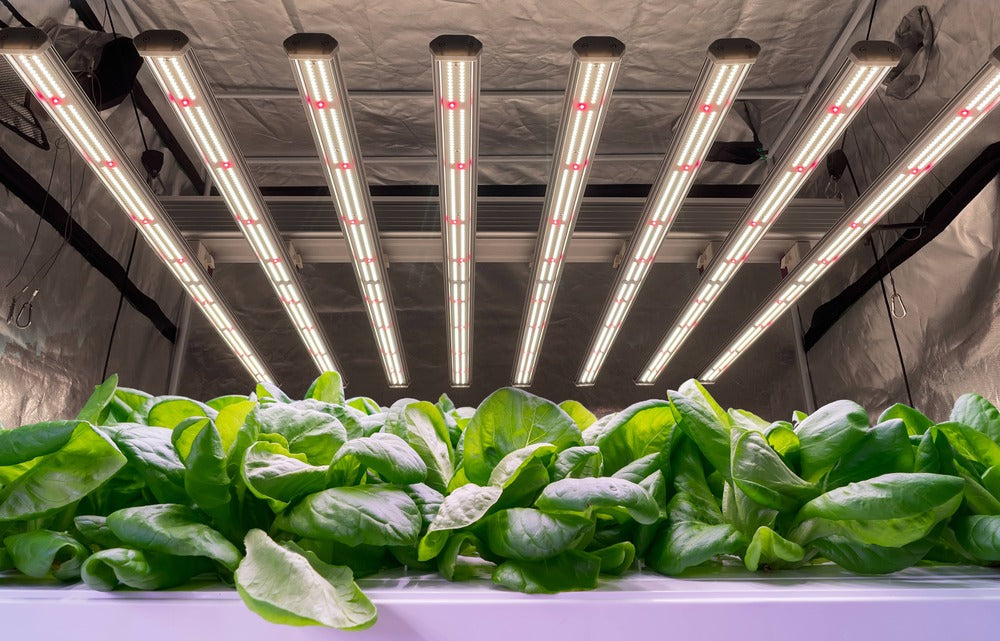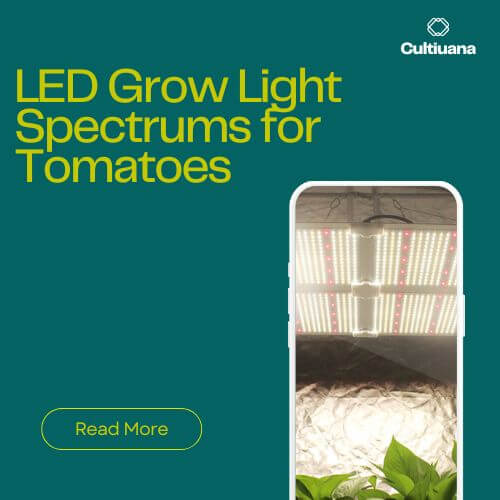
Full Spectrum LED Grow Lights 101: Buying Guides
So before we go ahead with any purchases, we should understand what exactly full spectrum LED grow lights are.
Full Spectrum LED Grow Lights Meaning
The full spectrum LED grow lights are specifically created to imitate the natural spectrum of sunlight and enhance plant growth.
It covers all the colors of visible light emitted by the sun, such as red, orange, yellow, green, blue, and indigo, spanning a wavelength range of 380nm to 780nm.
We all know that sunlight appears as white light, but in reality, this "white light" consists of seven colors - red, orange, yellow, green, blue, indigo, and violet.
So when we talk about "mimicking the sun" and "full spectrum," it means that plant lights aim to provide the same kind of light as sunlight.
However, our eyes cannot directly see all seven colors of light. We need to use the principle of light refraction and observe the light through a prism to see the seven colors.

Things to consider when choosing full spectrum LED grow lights
Before purchasing full spectrum LED grow lights, there are 13 important factors to consider to ensure you make the right choice for your indoor gardening needs. Here are some key considerations:
1. Light Wavelengths and Spectrums:
Pay attention to the wavelengths of light provided by the LED grow light to ensure it meets the specific needs of your plants.
380-400nm: This wavelength range consists of violet light, which is not absorbed as much by plants compared to other wavelengths.
400-520nm: Within this range, you'll find violet, blue, and fresh green light. Chlorophyll strongly absorbs light in this range, promoting photosynthesis and encouraging the growth of leaves and stems.
However, it's important to note that excessive exposure to blue light alone can result in elongated growth.
520-610nm: This range encompasses orange, yellow, and green light. Chlorophyll and carotenoids have relatively weaker absorption in this range, leading to less stimulation of photosynthesis compared to other wavelengths.
610-720nm: Red light dominates this range and significantly influences photosynthesis.
Chlorophyll has the highest absorption capacity for red light, promoting photosynthesis and playing a crucial role in the flowering and fruiting processes of plants.
The full spectrum led grow lights give it adjustable properties to adapt to different phases of growth.
Ideally, you would want to get a full spectrum, which includes UV lighting. That will help you save more, as you can have one set to do most, if not all, the growing phases.
2. Dimming
These lights are controlled with a dimmer, which gives you the option to adjust the level of light that you’d like to see in the room.
Dimmers also offer the ability to control light’s spectrum or color.
These features aren't necessary, but they may greatly enhance your grow space and yield.

3. Power
When it comes to power, it covers not just wattage, but also specifics such as Photosynthetic Photon Flux (PPF), efficacy, and average Photosynthetic Photon Flux Density (PPFD).
Ensure that the LEDs you are considering have sufficient PAR output and that the light intensity covers your entire canopy. In addition, consider adding IR and UV wavelengths for additional growth and protection.
4. Coverage
The size of your grow room or tent, known as the footprint, is crucial when deciding how many lights you'll need.
However, it's also essential to understand the connection between the intensity of LED grow lights and the area they can effectively cover.
This connection is described as the inverse square law of light. Without diving into intricate formulas, let's focus on the key point: as an object moves away from the light source, the intensity of the light it receives decreases.
This decrease happens rapidly, emphasizing the importance of proximity to maximize light intensity.
5. PPF
The PPF determines the photons your LED light emits that reach your plants. There's a whole other way to measure it. For a 36-square-meter growing area, your strain needs around 500 umol per square meter, so 1,800 umol/s of light is required.
To obtain the required PPF, you will need an LED grow light that produces 1,800 umol per second. It is important to know that PPF does not automatically equate to how much light a plant receives, but rather how much light it receives from a source.

6. PPFD:
PPFD, meanwhile, is how effective your plants can use the photons from the light. It tells you the number of PAR photons reaching your canopy each second. This metric is expressed as micromoles per square meter per second (or umol/m²/s).
Which PPFD number is good for what you're growing? It depends. Different plants need different types of light.
Certain flowers prefer about 300-600 umols for their vegetative state, whereas others prefer 800-1,000 umols in their flowering stage.
If you run a large commercial building, you will need an illumination of about 1,500-2,000 umol/s per square meter per second which can be supplemented with a CO2 enrichment system and other environmental systems.
7. Quality Construction and Materials:
One of the best benefits of LED lights is durability, which usually ranges from 5-10 years, depending on how they are made. At this time, you don't need to worry about making any changes to your setup.

8. Low Heat Output:
This is one of the main factors to consider when purchasing full spectrum LED grow lights, as it plays a role in plant protection and durability.
Since the lights are constantly near the plants, and the heat output is low, there is no danger of damage to the plants, but they also enable a shorter distance between the lights and the plants.
Furthermore, lights with higher heat output are more likely to burn out and must be replaced sooner. Well-balanced low heat output LED lamps emit less heat and are designed with aluminum heat sinks.
9: Quality Semiconductor Chip:
Within the LED, there is a semiconductor chip that produces light and regulates the wavelength of light.
Before buying a lamp, ensure that it has a power rating of at least 3 watts. Inadequate lighting is a concern if it does not have sufficient power.
10: Space for Growing Plants: The amount of space you have for growing plants significantly impacts your lighting choices, including the number and size of lamps required.
As a general rule, if you intend to grow high-light plants, you will need at least 32 watts of power per square foot of garden. Conversely, low-light plants like lettuce typically require only 11 to 18 watts.
11. Full Spectrum:
Plants can indeed grow under a wide range of light conditions, but they require different wavelengths to produce photosynthetic compounds at other times, which can be provided by the best full-spectrum led grow lights.
For instance, many plants need infrared, ultraviolet, and light in the red and blue spectrum; this may change in each growth stage. A powerful, full-spectrum LED grow light provides light that best meets the needs of the plants.
12: Adjustable and Easy to Use
Depending on your plant's type and stage of growth, you may need to adjust the position of your lamps. full spectrum LED grow lights are efficient, easy to use, and can be placed in any position you like.
Ensure that the wavelength and light intensity are adjustable as well. Look for products that are easy to maintain and ready to use right out of the box.

13: Returns and Warranties
Since the LEDs should last for about ten years or more under normal usage, you should be careful of warranties that last for a shorter duration of time. A warranty of less than 10 years usually indicates a poorer-quality item.
In most cases, manufacturers offer a warranty on the parts, which includes a free shipping and return policy.
Features of LED lights may still function even without the original, and there are times where you can send back a light part, in turn leaving you able to use your light even when a spare is still waiting to be delivered.
Are Full Spectrum LED Grow Lights Good for Growing Plants?
Yes, full spectrum LED grow lights are specially designed to provide plants with all the light spectrums they need for their complete growth cycle.
These LED grow lights even include a small amount of ultraviolet light, which naturally helps eliminate bacteria and control pests.
In the 400-420 nanometers wavelength range, the light serves a dual purpose. It restricts the growth of branches and leaves, while also encouraging the process of flowering in plants.
Moving on to the 450-460 nanometers wavelength range, the light emitted by these LEDs supports the growth of stems and leaves by regulating the opening of stomata, leading to overall better plant development.
Within the full spectrum, there is also light at a wavelength of 550 nanometers, which is extremely important.
This particular wavelength promotes the absorption of oxygen, enhances photosynthesis, and aids plants in rapidly accumulating vital nutrients.
For stimulating plant growth, shortening the flowering and fruiting cycle, and improving the quantity and quality of fruits, the light in the 650-660 nanometers wavelength range is particularly beneficial.
Lastly, the range of 720-1000 nanometers consists of light with a low absorption rate. This range specifically encourages cell elongation, affecting the flowering process and promoting seed germination in plants.
Overall, by providing the complete spectrum of light required by plants, full spectrum LED grow lights create the ideal lighting conditions for healthy and productive growth at every stage of the plant's life cycle.
- What colors are full spectrum LED?
The color of the full spectrum grow lights is white like the sunlight.
Full spectrum LED grow lights offer a wide range of light wavelengths. They cover all the colors we can see, like red, orange, yellow, green, blue, indigo, and violet.
But it doesn't stop there. It also includes some light that we can't see, such as near-infrared (ranging from 700 to 2,000 nanometers) and ultraviolet (ranging from 320 to 400 nanometers).
Although they contain a variety of visible colors. It appears as white to our eyes. This is because the LED light combines all these colors together in a balanced way.
The blending of different wavelengths creates the visual sensation of white light to our eyes. Although each color is present in the spectrum, their combination results in the overall perception of white light.
- What is the best light spectrum for indoor growing?
Full-spectrum is the best light spectrum for indoor growing. Why?
Keep reading.
As previously mentioned, sunlight is the ideal source of light for optimal plant growth. But sometimes, indoor plants can't get enough sunlight.
That's when full spectrum LED grow lights come in handy. They act as a substitute for sunlight by producing a mix of all colors needed for the plants to grow at every stage.
The color of the light we see depends on the length of the waves of light. Shorter waves, around 450 to 490 nanometers, make the light appear blue.
On the other hand, longer waves, about 635 to 700 nanometers, make the light appear red. When we observe light with our eyes, we only perceive it as one color.
However, in reality, light is usually a mix of various wavelengths, not just one. The collection of different wavelengths and the quantity of photons at each wavelength is called the spectrum of light.

Let's take a look at these different spectra and understand how they impact your plants.
UV Light (10nm-400nm):
UV light, which falls within the wavelength range of 10nm to 400nm, doesn't directly aid in photosynthesis but has been studied for its ability to enhance the production of terpenes and anthocyanins in plants.
These compounds can improve the color, aroma, and flavor of flowers.
Blue Light (400nm-525nm):
Blue light, ranging from 400nm to 525nm, plays a crucial role in photosynthesis and affects the physical structure of plants, making them grow more compact and denser.
However, certain types of lighting technologies, like HID lights, may not provide enough of this spectrum.
Visible Par Light (400nm-700nm):
This range, spanning from 400nm to 700nm, is essential for photosynthesis and considered the most important for plant growth.
While this range is widely accepted, scientists have conducted tests suggesting that even far-red light up to 750nm contributes to photosynthesis and propose expanding the range.
Red Light (600nm-700nm):
Red light, ranging from 600nm to 700nm, also contributes to photosynthesis and influences plant morphology by causing them to stretch.
Red light is particularly efficient when generated by LEDs, offering more light output per watt of power used.
Far Red Light (700nm-750nm):
Recent research has brought attention to the previously overlooked range of 700nm to 750nm in the spectrum, known as far-red light.
It has been found to provide significant benefits for plant growth, including increased leaf size, which enhances light absorption and overall plant development.
Contrary to previous beliefs, it has also been discovered that far-red light contributes to photosynthesis.
Once we understand how different wavelengths affect plants, it becomes clear that full-spectrum light is specially designed to meet the needs of plants at every stage of growth.
It creates an ideal working environment for growers. That's why, when it comes to indoor growing, using full-spectrum light is the best choice for achieving optimal results.
What is the best full spectrum led grow lights
Cultiuana CT-800 is one of the best full spectrum LED grow lights. The CT-800 spectrum is carefully crafted to maximize yields and promote greater plant growth in greenhouse settings.
It is specifically designed for indoor use, serving as the sole light source throughout all stages of the growth cycle. This spectrum allows plants to absorb the wavelengths they require, precisely when they need them.
How to Use Full Spectrum LED Grow Lights?
Most full spectrum LED grow lights come equipped with a dimming feature, and if they don't, they can still be connected to an additional LED grow lights controller for adjusting the light intensity.
Once you hang the full spectrum LED grow lights, you can use the built-in dimmer to customize the light intensity according to your plants' specific needs.
For example, let's consider the Cultiuana CT-800 full spectrum LED grow light in a 4x4 indoor grow tent.
During the seedling stage, it's recommended to dim the light to around 30% to 40% at a height of 24" to 30".
In the vegetative stage, you can increase the intensity to around 80% at the same height.
During the flowering stage, maintain the same 80% intensity but lower the light to 12".
If you are growing in a 5x5 grow tent, the recommended settings would be different.
For the seedling stage, dim the light to approximately 60% at a height of 24" to 30".
In the vegetative stage, keep the intensity at 100% at the same height.
During the flowering stage, maintain 100% intensity but lower the light to 24".
Remember, these settings are just examples and can vary depending on the specific LED grow light and the needs of your plants.




